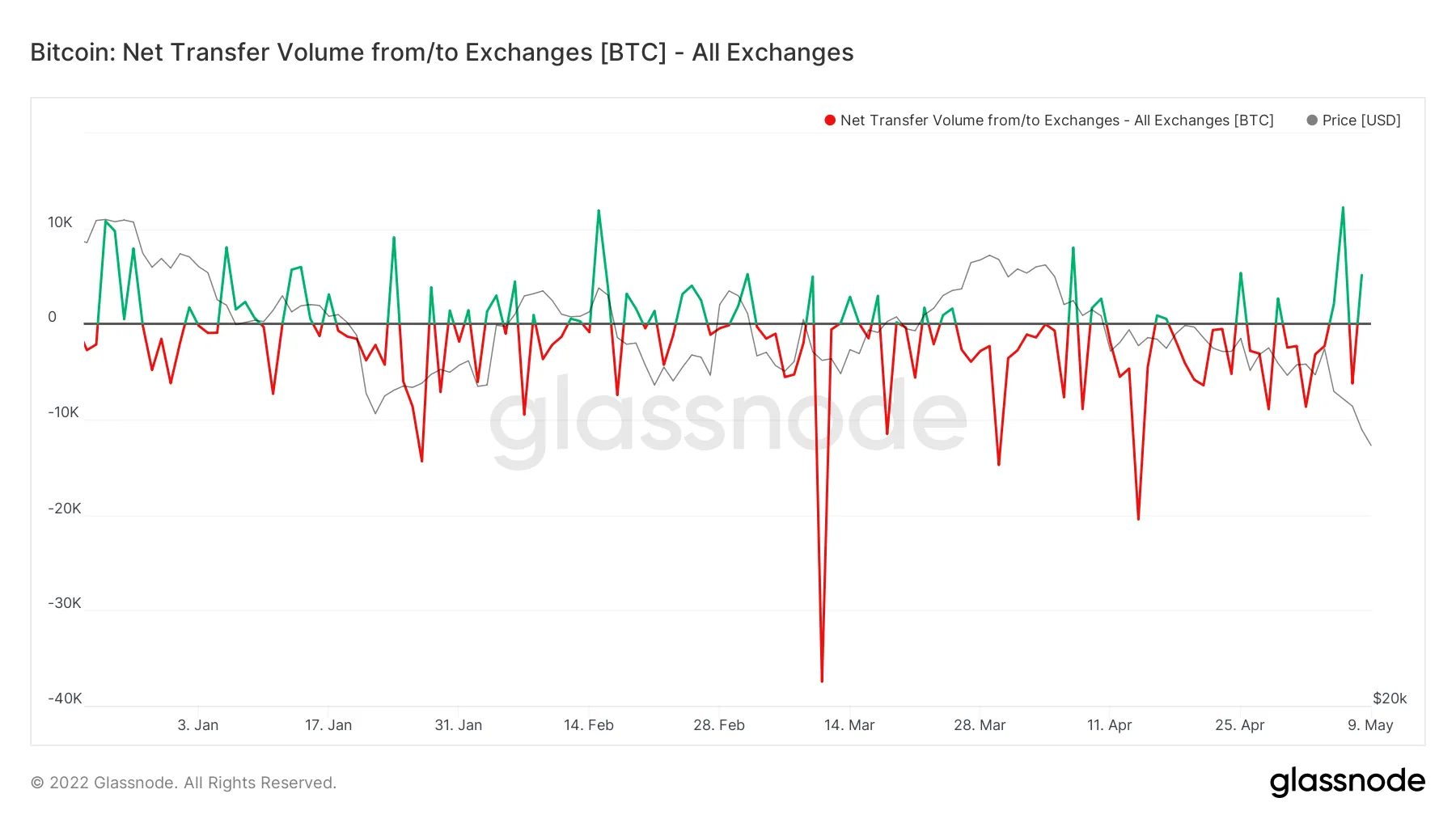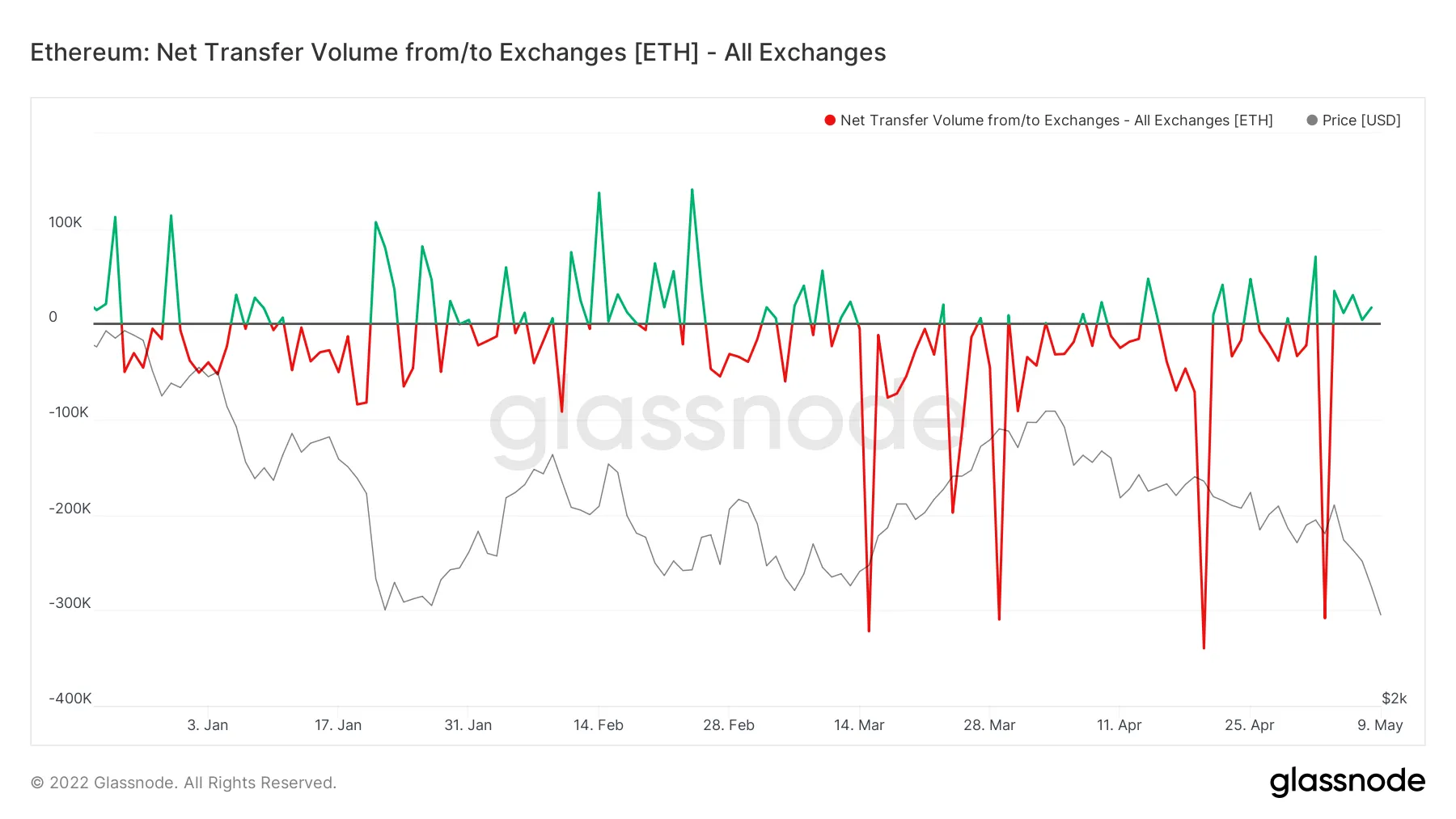Bitcoin, Ethereum: Inflows and outflows


Disclaimer
The views and opinions expressed by the author are for informational purposes only and do not constitute financial, investment, or other advice.
$91,186.00
-1.58%$3,157.06
-2.84%$2.20
-3.54%$898.37
-1.04%$135.51
-2.36%$0.9999
-0.00%$0.297569
1.81%$3,157.02
-2.78%$0.147401
1.27%$1.035
0.29%$0.403811
-1.43%$630.38
-0.27%$3,862.36
-2.90%$56.51
-2.67%$3,430.28
-2.85%$90,858.00
-1.72%$3,422.04
-3.00%$0.999512
-0.01%$13.41
-2.58%$0.999017
-0.07%$9.00
1.06%$3,154.07
-2.86%$438.26
-0.54%$480.25
-5.52%$0.235935
-1.63%$1.85
-0.30%$91,121.00
-1.55%$26.68
-1.11%$0.999266
-0.03%$81.44
-1.36%$13.98
-3.56%$0.123406
-3.12%$0.00000893
-1.03%$0.133523
-7.05%$1.085
-0.19%$1.89
0.83%$0.167474
-2.54%$0.999351
-0.02%$0.104185
-3.22%$1.00
0.03%$5.73
-4.61%$1.21
-0.00%$2.14
-1.18%$0.998996
-0.06%$1.025
-5.56%$0.00881208
-3.26%$1.67
2.97%$0.00000676
4.53%$270.18
-5.01%$167.02
-1.89%$3.52
-1.43%$111.67
-1.70%$4,453.95
-0.42%$1.72
-2.75%$0.997328
0.12%$12.78
-2.14%$169.80
-2.43%$3,152.46
-2.88%$0.236552
-4.42%$0.741177
-3.07%$3.22
-2.69%$0.208638
-1.15%$1.00
0.00%$4,470.07
-0.65%$135.49
-2.39%$0.596838
-4.43%$0.00000169
0.73%$4.74
-1.40%$0.02930776
-1.27%$0.99961
0.00%$1.11
0.00%$11.43
-0.99%$1.15
0.00%$148.04
-2.33%$0.06183
-2.16%$1.88
-1.30%$0.00233918
-3.53%$0.42612
-4.77%$1.00
0.05%$0.126794
-0.53%$0.998877
-0.04%$0.078853
3.04%$3,641.09
-2.87%$897.52
-1.06%$0.04849249
-4.53%$0.999599
0.01%$10.36
-1.67%$0.211722
-2.42%$0.136589
-1.51%$2.31
-3.62%$2.40
-1.20%$3,344.27
-3.09%$1.51
-3.73%$75.65
-2.51%$5.43
0.19%$0.01217011
-3.12%$0.00001168
-1.06%$3,854.07
-2.75%$91,056.00
-1.88%$91,440.00
-1.42%$0.01194942
-4.61%$90,969.00
-1.65%$0.97401
-0.97%$1.021
0.01%$0.050254
-4.63%$4.83
1.25%$3,354.01
-2.87%$0.998855
-0.10%$1.00
0.08%$113.88
0.01%$0.125326
-3.33%$3,406.80
-2.92%$0.999955
0.08%$0.01227447
-2.71%$10.95
0.01%$90,916.00
-1.69%$0.999699
0.00%$2.86
-7.50%$3,366.73
-2.93%$91,136.00
-2.50%$1.12
1.04%$2.04
-0.45%$0.01192903
-4.91%$1.057
-5.25%$0.216586
-3.85%$1.11
0.02%$0.088927
-1.40%$1.22
-2.88%$0.999104
-0.13%$3,153.18
-2.93%$1.94
-5.09%$3,326.24
-2.88%$0.3556
-2.82%$157.40
-2.37%$0.278426
-5.03%$0.9998
0.00%$0.316721
-1.92%$26.89
-1.23%$0.569885
-2.05%$0.409123
-2.89%$1.22
-0.00%$0.127344
-1.46%$0.595471
-3.68%$0.999312
0.09%$0.00005634
-0.33%$90,807.00
-1.95%$0.635165
-2.33%$5.27
-4.03%$41.35
-6.08%$3,156.49
-2.82%$0.559032
-5.55%$0.998485
-0.06%$3,152.91
-2.91%$0.999807
0.13%$0.75646
-3.85%$0.997907
-0.01%$0.567207
-1.29%$1.087
0.10%$182.94
-2.44%$3,403.45
-2.72%$3,383.21
-3.51%$0.107572
-3.19%$0.087516
-4.05%$0.217806
-2.51%$0.04269858
-0.94%$0.04053652
-2.48%$0.00873764
-3.77%$0.00000043
-3.63%$0.00445412
-1.20%$0.04274856
3.61%$0.418909
-2.18%$168.55
-1.55%$0.358593
-6.27%$90,840.00
-2.95%$0.117986
-4.39%$10.71
-2.93%$3,530.67
-2.96%$0.078307
-2.01%$0.987927
-0.06%$0.397018
-8.69%$0.068398
-1.90%$0.066992
-4.25%$19.59
-4.50%$0.02033239
0.84%$1.11
0.01%$0.913992
-1.30%$0.147257
1.20%$0.182299
-6.06%$0.00391417
-4.23%$3,157.60
-2.70%$0.369526
-0.46%$139.79
-1.54%$0.00000037
-0.56%$2.16
-4.05%$1.17
0.00%$21.79
-0.47%$1.002
0.18%$91,096.00
-1.34%$146.97
1.79%$0.09249
-4.10%$0.00729433
-1.83%$0.00932554
-8.30%$1.00
-0.12%$17.35
-3.73%$0.216946
-3.16%$0.120591
-3.15%$16.32
-29.44%$1.00
-0.02%$0.090725
-0.80%$1.17
-3.14%$1.13
0.05%$0.99853
-0.15%$3,416.37
-2.92%$0.304804
-2.83%$1.091
0.02%$0.999261
-0.00%$80.69
0.53%$91,122.00
-1.48%$3,148.51
-2.85%$0.03449936
-4.82%$0.02734875
-6.90%$16.98
-3.14%$1.55
-1.02%$0.177946
-2.62%$0.156829
-0.43%$3,151.72
-2.91%$0.00294965
-3.62%$1.40
-0.60%$3.99
0.19%$0.280443
-17.41%$3,427.57
-2.40%$0.992888
0.02%$951.61
-1.15%$91,650.00
-1.37%$0.141339
-1.02%$26.64
-1.50%$0.269618
7.24%$0.245302
1.84%$2.60
-0.20%$3,160.94
-2.50%$90,518.00
-2.23%$0.01451449
-6.53%$26.78
-0.09%$0.259599
-2.41%$3.92
-3.05%$3,859.36
-2.92%$23.01
-1.16%$1.55
-1.62%
Having spent the last five weeks in decline, the industry’s largest cryptocurrencies by market capitalization, Bitcoin and Ethereum, are currently down roughly 50% from their all-time highs posted during the 2021 bull run.
Leading cryptocurrency Bitcoin still dominates 41.8% of the market with a capitalization of $628 billion. It's trading at $32,947 – a level not seen since July 2021, according to crypto data aggregator CoinMarketCap.
This figure records a 51.98% drop in value since Bitcoin set its all-time high of $68,789 on November 10, 2021.
It’s a similar story with the second most popular coin, Ethereum.
Ethereum has a market dominance of around 19.2%, with a current capitalization of $289 billion, but today it’s worth $2,395, or about 50.8% of its former high of $4,891.70, posted on November 16, 2021.
Part of Bitcoin’s recent price movement can be understood in light of its inflows and outflows on exchanges. Greater inflows typically signal an imminent bear market as investors move their holdings onto exchanges to sell for fiat or fiat-pegged stablecoins.
Conversely, greater outflows can be a bullish signal as investors may be moving their holdings to cold storage wallets for long-term holding.
According to data from Glassnode, Bitcoin’s 15% dip over the last seven days also correlates with net transfer volumes to various exchanges. On May 6, there was a net inflow of approximately 12,246 Bitcoin or roughly $402 million at today’s price.

Notably, Ethereum’s net transfer volumes for this month indicated that most investors have been moving their holdings off of exchanges (typically seen as a bullish signal for an asset).
The contradiction between Ethereum's recent bearish price action accompanied by large outflows from exchanges suggests that there may be other forces at play for the number two cryptocurrency.

For one, Ethereum holders may be pulling their idle coins from exchanges for staking purposes leading up to the network’s merge expected in Q3.
Investors could also be dumping their Ethereum holdings on various decentralized exchanges (DEXs) within the world of DeFi, the likes of which are not tracked by Glassnod. For example, when comparing transaction volume for Ethereum on Coinbase and DeFi’s largest decentralized exchange Uniswap, the latter reports a trading volume of $1.63 billion over the last 24 hours, whereas the former reports just over $500 million.
If not decentralized exchanges, the Ethereum that's leaving from exchanges could be getting deployed in lending or borrowing protocols, being used to mint stablecoins, or a host of other DeFi activities that do not result in selling the asset.
The same level of DeFi activity cannot, however, be said for Bitcoin.
Disclaimer
The views and opinions expressed by the author are for informational purposes only and do not constitute financial, investment, or other advice.
